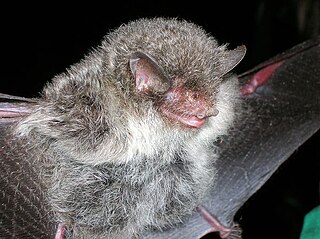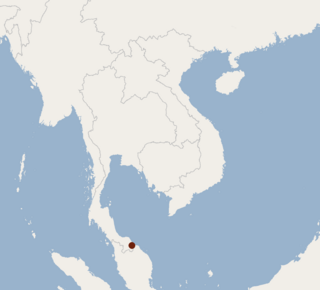
The Japanese house bat, also known as Japanese pipistrelle, is a species of vesper bat. An adult has a body length of 3.6–4.8 cm (1.4–1.9 in), a tail of 2.9–4.0 cm (1.1–1.6 in), and a wing length of 3.2–3.6 cm (1.3–1.4 in). It prefers to roost under the ceiling or inside the roof of old buildings. It is found across East Asia, from China and Taiwan into the Ussuri region, the Korean Peninsula, and Japan.

Hodgson's bat, also called the copper-winged bat or black-and-orange myotis, is a species of vesper bat in the genus Myotis, the mouse-eared bats. Favouring mountain forests, it is found throughout Central, Southeast, and East Asia, from Afghanistan to Taiwan. It is about 5 centimetres (2.0 in) long and is distinguished from most other species of bat in this range by its yellowish colouration.

Murina is a genus of vesper bats. They are found throughout temperate and tropical regions of Asia.
The Taiwan tube-nosed bat is a species of vesper bat in the family Vespertilionidae. It is found only in Taiwan. It is a close relative of Hutton's tube-nosed bat, and might even be the same species.

The gilded tube-nosed bat is a species of vesper bat in the family Vespertilionidae.
The gloomy tube-nosed bat is a species of vesper bat in the family Vespertilionidae. It is only known by the holotype, an old female, collected on Tsushima Island in 1962. It might be possibly extinct as Tsushima is badly deforested and surveys to rediscover this species failed. Due to its imperiled status, it is identified by the Alliance for Zero Extinction as a species in danger of imminent extinction.

The Ussuri tube-nosed bat is a species of vesper bat in the family Vespertilionidae. It is threatened by habitat loss. It is the only species of bat that hibernates in snowbanks.

The necklace sprite or necklace pipistrelle is a species of vesper bat that is endemic to Taiwan.

The Murininae are a subfamily of bats in the family Vespertilionidae. They include the tube-nosed bats and hairy-winged bats in the genera Murina, Harpiola, and Harpiocephalus.

Harrison's tube-nosed bat is a species of vesper bats (Vespertilionidae). Within the genus Murina, it belongs to the so-called 'cyclotis-group'.

Hilgendorf's tube-nosed bat is a species of vesper bat in the family Vespertilionidae. In Japan they are called 'tengu komori', after the mythical creature called the Tengu. It was formerly thought to be a subspecies of Murina leucogaster, but is now known to be a distinct species.

Beelzebub's tube-nosed bat, also Beelzebub bat or demon bat, is a species in the vesper bat family Vespertilionidae, found in the Greater Mekong region of Southeast Asia, specifically the Quảng Trị and Gia Lai provinces of Vietnam. They have tube-shaped nostrils which assist them with their feeding.
The slender tube-nosed bat is a species of vesper bat in the family Vespertilionidae found only in Taiwan.
The Formosan golden tube-nosed bat is native to the high-altitude regions of Taiwan.

The Bala tube-nosed bat is a critically endangered species of bat found in Thailand.
The bicolored tube-nosed bat is a species of vesper bat endemic to Taiwan.
The Hkakabo Razi tube-nosed bat, also known colloquially as the Lance Bass bat is a species of vesper bat in the family Vespertilionidae. It is found only in Myanmar. The bat earned its nickname due to its spiky blonde pelage, which reminded people of Lance Bass, a member of the boy band NSYNC.











